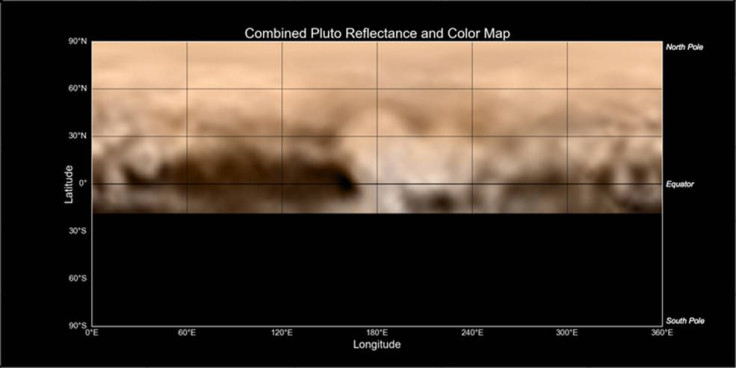New Horizons Maps Pluto, Shows ‘The Whale’ And ‘The Donut’

NASA’s New Horizons spacecraft, which is preparing for its July 14 flyby of Pluto, has helped astronomers create the latest map of the planet, developed using images taken from June 27 to July 3. The center of the map matches the side of Pluto, which will be seen more accurately when New Horizons comes closer to the planet next week.
The map has served as an important tool for the mission scientists to decode the complex pattern of bright and dark spots on Pluto’s surface. According to NASA, New Horizons is expected to provide higher-resolution images in the days to come, allowing scientists to better understand Pluto’s terrain and make more accurate maps.
“We’re at the ‘man in the moon’ stage of viewing Pluto,” John Spencer of the Southwest Research Institute in Boulder, Colorado, said in a statement. “It’s easy to imagine you’re seeing familiar shapes in this bizarre collection of light and dark features. However, it’s too early to know what these features really are.”

The map, made from images taken by the Long Range Reconnaissance Imager aboard New Horizons, shows an elongated dark area, informally called “the whale,” along the equator on the left side. The area is one of the darkest regions on Pluto visible to New Horizons and nearly 1,860 miles in length, scientists said.
The brightest region visible on Pluto lies to the right of the whale’s “head.” It is about 990 miles across and believed to be a region where fresh deposits of frost -- perhaps including frozen methane, nitrogen or carbon monoxide -- form a bright layer. Near the whale’s “tail” on the left side, scientists spotted a bright donut-shaped feature, which is about 200 miles across.
New Horizons, which was unexpectedly shut down on July 4 due to an anomaly, beamed back the new images of Pluto earlier this week.
Compared to other planets in the solar system, scientists know very little about Pluto because of its distance from Earth, which is about 4.67 billion miles. However, scientists expect to better understand the dwarf planet as well as its mysterious moon, Charon, when New Horizons will pass within 7,800 miles of Pluto’s surface next week.
© Copyright IBTimes 2025. All rights reserved.






















